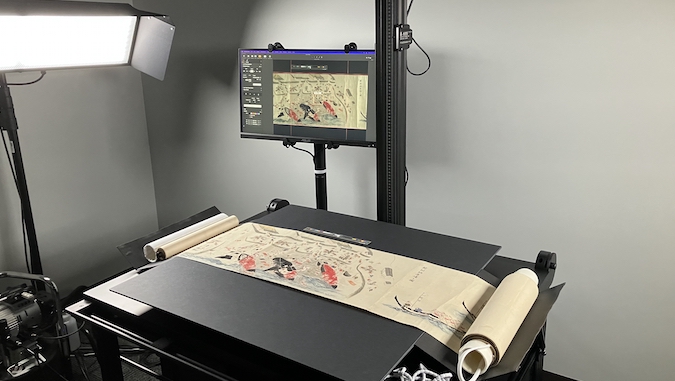
Students and scholars at the University of Hawaiʻi at Manoa (and worldwide) can now easily access and view the fine details of rare, hand-painted Japanese scrolls, made possible by UH Mānoa Library’s new state-of-the-art digitization lab. The scrolls titled 鯨魚鑬笑録 (Geigyo ranshōroku), or “A simple overview of whaling” were created in 1819 and gifted to UH in 2020 by Deborah Rudolph to honor the memory of her late husband, John Harvard Hawley. They depict the entire process of whale hunting during Japan’s Edo period (1600–1868).
Previously only viewable in-person and by appointment in the library’s Asia Collection, the scrolls are now available online in high resolution, beyond what a user would see in person.
The digitization project was the library’s largest and most challenging to date, with the two scrolls measuring 39 feet and 35 feet, respectively.
“The level of detail we were able to capture was excellent,” said Clem Guthro, UH Mānoa Librarian. “If you zoom close enough, you can see the brush strokes in the pigment, the grain of the paper and accumulated damage over the past two hundred years.”

Conservation and digitization

Conservation work on the scrolls began in 2021 and took six months, followed by planning for digitization, which took another few months. The digitization was completed in December 2022, and the StoryMap showing the display of the scrolls, cataloging and annotation work, was completed in June 2023.
“The care and handling of the scrolls was a collaborative effort, mainly between the Preservation Department and the Digitization Lab,” said Ted Kwok, a geospatial librarian. “Planning was key for effective object handling and digitization, including researching how other institutions handled scrolls, building a scroll carrier system, and establishing a workflow so everyone knew what to expect on the day of digitization.”
The images are provided through the International Image Interoperability Framework, which allows students, faculty and researchers worldwide to examine, compare, annotate and share images and documents.
Cutting-edge lab facility
The library upgraded its digitization lab in August 2022 with new high-quality imaging equipment and lab space configured for camera-based image capture and processing workflow.
“For example, the room was painted with a neutral gray; we have large tables, shelving and carts for the organization of projects; lighting controls; HEPA filters to reduce dust; and powerful computers for processing large and numerous images,” Kwok explained.
“With the library’s many treasures throughout its collections and archives, including historical and rare documents, manuscripts, photographs, maps and artwork, we now have what can easily be considered one of the best cultural digitization labs in the state,” said Guthro. “Our lab is small, but can digitize at a level that traditional scanners can’t come close to.”
The library’s next big digitization project will be 400 volumes of Korean material from the Asia Collection.


